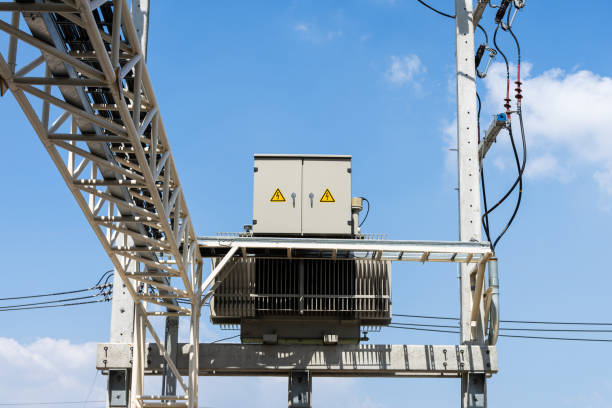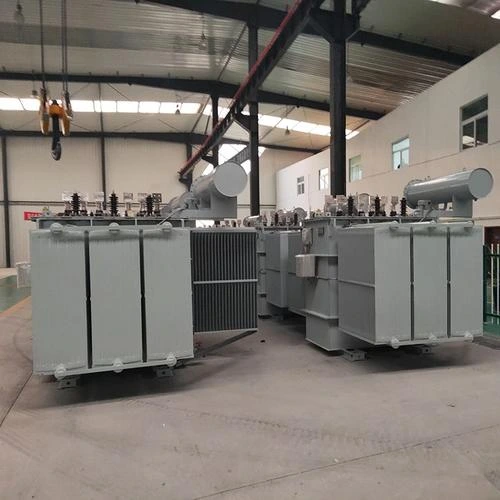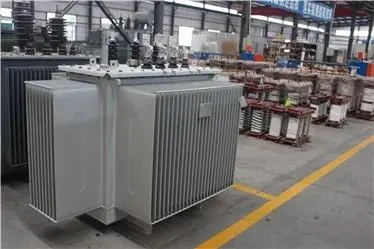ELECTRIC, WITH AN EDGE
The utility grid is a complex power transmission and distribution line, utility transformers, and other equipment. The cost of the equipment used to transport energy from this grid is very high.
Electric utility companies are constantly upgrading their infrastructure to meet the growing electricity demand.
So, they look for electric utility transformers and distribution line products that are designed to be efficient and reliable.
All while maintaining a high level of safety and reliability on our products.
DAELIM provides transformers, transformers with accessories, and other top-notch electrical products.
The company has more than 10 years of experience in the field of electrical design and production. It is one of the leading companies specializing in transformer manufacturing and distribution.
Daelim Belefic is a trusted supplier of high-quality utility transformers that are designed to meet the specific needs of different customers and industries. As a leading manufacturer of transformers, Daelim Belefic offers a wide range of products that are engineered to provide reliable performance and long service life.
Our utility transformers are manufactured according to international standards such as IEC 60076, GB 6451, AS NZS 60076, CSAC88-16, ANSI/IEEE C57.12.00, and GOST R 52719, ensuring the highest levels of quality and safety. With over 30 years of experience in the industry, we have built a reputation for providing exceptional products and services to our customers.
Our utility transformers are designed for a wide range of applications, including power transmission and distribution, renewable energy systems, industrial processes, and more. We offer transformers in various sizes and configurations, including single-phase and three-phase transformers, pole-mounted transformers, and pad-mounted transformers.
At Daelim Belefic, we are committed to providing our customers with the highest levels of customer service and support. Our team of experts is always available to help our customers with their transformer needs, from initial consultation to after-sales support.
If you’re looking for a reliable supplier of high-quality utility transformers, look no further than Daelim Belefic. Contact us today to learn more about our products and services, and how we can help meet your transformer needs.
Electric Pole Transformer | Single Phase Transformer
-Learn the fundamentals of Electric Pole Transformers, including What is pole mounted distribution transformer, pole mounted transformer specifications, pole mounted transformer drawing, pole mounted transformer sizes and custom options.
A Complete Guide to Utility Electric Pole Transformer
-A Utility electric pole transformer is an electric utility distribution transformer mounted on a service pole. Check More.
A Complete Guide to Single Phase Distribution Transformer
-Consumers use electricity for different industries. Transformers work to make this happen as single phase distribution transformers.
Single Phase Transformer: What is it?
-Learn the fundamentals of Single Phase Transformers, including What is it, how does it work, common types, and custom options.
In the simplest terms, a utility transformer is a transformer that transports electricity from a utility power grid to consumers.
According to their usage, utility transformer sizes are divided into two broad categories:
Residential electrical transformer – It must be less than 150 millimeters in diameter.
Large commercial electrical transformer – It must be greater than 150 millimeters in diameter.
Each size of the transformer operates at different voltages.
For example, large commercial electrical transformers supply high output and low impedance, while residential transformers supply low and high impedance.
A utility transformer is a type of transformer used by utility companies to step up or step down voltage levels in electrical power transmission and distribution systems. These transformers are an essential component of the electrical grid, which delivers power from power plants to homes, businesses, and other electrical loads.
Utility transformers typically operate at high voltages, such as 69 kV, 138 kV, 230 kV, or even higher. They are used to step up the voltage of electrical power from power plants to reduce the amount of current needed for long-distance transmission. At the point of consumption, another transformer is used to step down the voltage to levels suitable for use by homes and businesses.
There are two main types of utility transformers: step-up transformers and step-down transformers. Step-up transformers are used to increase the voltage level of electrical power from power plants for long-distance transmission. Step-down transformers are used to decrease the voltage level of electrical power for use by homes and businesses.
Utility transformers come in various sizes, depending on the voltage and power levels they are designed to handle. Larger transformers are used for high voltage transmission and distribution systems, while smaller transformers are used for low voltage distribution systems.
Overall, utility transformers are an essential component of the electrical grid, allowing for efficient and safe transmission and distribution of electrical power.
In the utility industry, it’s not just about the power output of the transformer, but also its size and frequency.
Just take note that if you want a high output transformer, you need a big one.
The design of utility transformers sizes is a process that involves several steps.
Some transformers use compression, while others use a relatively pure sine wave sent through an inductor or transformer.
A pure sine wave that passes through the inductor results in low distortion.
In addition, a pure sine wave that passes through the transformer results in greater than 200% output power.
In the United States, there are three main types of utility transformers: solid-state, air-filled, and air-forced.
The size, shape, and material used for different types of transformers are different.
It’s important to use the right transformer for the right job.
It’s worth doing a little bit of research to find the best transformer for your application.
Here are some for you.
The right transformer can help save money on electric bills.
It also helps reduce carbon footprint, which is important when it comes to our global economy.
You may wonder what are the benefits of utility transformers, so here are as follows:

Transformers convert high voltages (a few hundred thousand volts) to lower voltages (sub-steps).
The power is converted from one voltage to another and transmits the energy safely across the high-voltage grid.
This is a complicated process but a very important one.
Power in a small region converts into a much higher voltage (i.e., an electric power transmission) with a transformer.
The high voltage can then transmit power from a centralized or isolated substation to a commercial or industrial area.
A few years back, utility companies had a very limited option for buying power transformers.
They had to buy standard-size transformers with low ratings for reliability.
This resulted in a heavy inventory of standard transformers in the marketplace.

The main purpose of a utility transformer is to transfer electricity from a power source to a distribution system.
It’s a device that serves as a major link in the power transmission process.
Its job is to keep you safe from electrical surges, overloads, and other power-related hazards.
The transformer provides power for the home without damaging the circuits in your home.
It also allows your home to be more energy-efficient.
A utility transformer transforms electric current from the substation to the power lines in homes or businesses.
Using a proper one is a crucial piece of equipment for industrial and commercial applications.
Utility transformers and electrical sockets work with each other, but they are very different.
A utility transformer is a device that transforms high-voltage electricity into low-voltage electricity and vice versa.
Meanwhile, an electrical socket is a device that connects to an electrical outlet and lets you plug it in.
These are beneficial for almost all modern appliances and light fixtures.
Not only can you use a more powerful electric current, but it will be delivered at a higher voltage too.
The amount of power they generate depends only on the size of the transformer, or what we call an ‘amp rating.’
You can use a light socket to light up a room, or a lamp can be used for reading.
An outlet is also perfect for plugging in your gadgets and chargers.
However, a utility transformer will have many other uses.
The 3-phase utility transformer is an electrical transformer designed to transform three-phase power to single-phase power.
The three phases are hot (H), neutral (N), and ground (G).
The distributor then sends the power through the circuit to the loads.
Additionally, a 3 phase utility transformer converts the three phases of electricity into two phases.
It also has an automatic switch mechanism that automatically turns off the power supply when it senses reduced power demand.
The pole-mounted transformer drawing is a powerful transformer used to power large electrical installations.
High-rise buildings and large power substations use these transformers to support the massive electricity demands of the buildings themselves.
They can withstand the extreme voltage fluctuations of high voltage lines and heavy currents.
In addition, the pole-mounted transformer is a type of transformer installed on the outside of the building.
It is mounted on a pole, as the name implied, and there are no floor connections.
These transformers can run in high voltage, and long cable runs where access to the transformer is limited.

The answer is yes.
The transformer is the electrical device that converts AC to DC voltage for batteries, other loads, or appliances.
However, due to the differences in transformer size and shape, power usage can vary.
AC transformers run on AC, whereas DC transformers run on a different kind of electricity called DC.
As a result, the output of a utility transformer is either on AC or off AC.
You can easily identify a utility transformer by looking for metal housing with a black stripe around the outside.
A utility transformer is a transformer that produces electricity.
A DC transformer produces AC.
AC transformers supply power to commercial and industrial electrical systems, while DC transformers supply power to household electrical systems.
The output of the transformer is the voltage.
It is also what we call the ‘voltage source.’
The power delivered by the utility transformer varies depending on the type of load connected.
The load consists of the cable, cable termination, and other components connected to or disconnected from it.
With a utility transformer, a specialist can turn a common household appliance into a sizable generator.
The utility transformer is the only model that does not need to be connected to the electrical grid.
It simply heats up when it feels like it, but it remains in place and can operate when needed.
It’s perfect for home and commercial use.

There are several types of utility transformers, each designed for a specific application or use. Here are some of the most common types:
Power Transformers: These transformers are used to transfer electrical energy from one circuit to another. They are typically used in power transmission systems to step up or step down voltage levels.
Distribution Transformers: These transformers are used to distribute electrical power from a transmission system to individual customers. They are generally smaller than power transformers and operate at lower voltages.
Instrument Transformers: These transformers are used to measure electrical quantities such as voltage and current. They are used to provide signals to protective relays, meters, and other devices.
Auto-Transformers: These transformers are designed to transfer electrical energy from one voltage level to another within the same system. They are generally smaller and more economical than conventional transformers.
Isolation Transformers: These transformers are used to isolate electrical equipment from the power supply to provide safety and protect against electrical noise.
Step-Up Transformers: These transformers are designed to increase the voltage level of the electrical energy being transmitted over a long distance. They are used in power transmission systems.
Step-Down Transformers: These transformers are designed to decrease the voltage level of the electrical energy being supplied to customers. They are used in distribution systems to reduce the voltage level to safe levels for home and business use.
Rectifier Transformers: These transformers are used to supply rectifier circuits with the required AC voltage and current for DC power supplies.
In general, utility transformers are designed to transfer electrical energy efficiently and safely from one circuit to another, ensuring that electricity is available for use by customers in homes, businesses, and other industries.
Utility transformers come in various sizes depending on their capacity and application. The sizes of utility transformers are typically measured in terms of their kilovolt-amperes (kVA) rating, which is a measure of their maximum power capacity.
The smallest utility transformers can have a kVA rating of around 5 kVA and are used for small-scale applications such as residential power distribution. Medium-sized utility transformers can range from 25 kVA to 500 kVA and are typically used in commercial and industrial applications, while larger utility transformers can have a kVA rating of over 1,000 kVA and are used in high voltage power transmission and distribution networks.
In addition to kVA ratings, utility transformers can also be classified according to their voltage class, which refers to the maximum voltage that they are designed to handle. The most common voltage classes for utility transformers are 15 kV, 25 kV, and 35 kV.
It is important to select the appropriate size and voltage class of utility transformer for a particular application to ensure safe and efficient operation. The selection of the appropriate transformer size will depend on factors such as the power requirements of the load, the voltage level of the power source, and the overall electrical system design. Consulting with a qualified engineer or transformer supplier can help ensure that the appropriate transformer is selected for a given application.
ABB Distribution Transformer Manufacturer

A distribution transformer works on the principle of electromagnetic induction, which is based on the relationship between an alternating electric current and a magnetic field. The transformer has two coils of wire, the primary coil, and the secondary coil, which are wrapped around a core made of magnetic material such as iron.
When an alternating current is passed through the primary coil, it creates a magnetic field that flows through the core and induces a voltage in the secondary coil. The voltage induced in the secondary coil is proportional to the ratio of the number of turns in the secondary coil to the number of turns in the primary coil.
The distribution transformer steps down the high voltage electricity from the transmission system to the lower voltage levels that are suitable for use in homes and businesses. This is achieved by varying the number of turns in the primary and secondary coils, which determines the ratio of the input voltage to the output voltage.
The working principle of a distribution transformer involves the transfer of electrical energy from the primary coil to the secondary coil through the magnetic field, with minimal loss of power. The transformer also provides electrical isolation between the primary and secondary circuits, ensuring safety and protection against electric shock.
A distribution transformer has several components that work together to transform and distribute electrical power. The main parts of a distribution transformer are:
Core: The core is made up of laminations of magnetic material, typically steel, which are used to conduct magnetic flux.
Windings: The windings are made up of insulated copper wires and are used to conduct electrical current. There are typically two windings in a distribution transformer: the primary winding and the secondary winding.
Insulation: Insulation is used to separate the windings and to prevent electrical current from flowing between them.
Tank: The tank is a steel enclosure that houses the core, windings, and insulation. It also contains cooling equipment such as radiators and fans.
Tap changer: The tap changer is a device that allows the transformer’s output voltage to be adjusted.
The functions of these components are:
Core: The core provides a path for the magnetic flux, which is essential for the transformer’s operation.
Windings: The windings conduct electrical current and are responsible for the transfer of electrical energy between the primary and secondary circuits.
Insulation: Insulation prevents electrical current from flowing between the windings, which is essential for the transformer’s safe and reliable operation.
Tank: The tank houses the core, windings, and insulation, and provides a safe and secure environment for the transformer’s operation.
Tap changer: The tap changer allows the transformer’s output voltage to be adjusted, which is necessary to compensate for changes in load or voltage regulation.
Overall, the different parts of a distribution transformer work together to transform high voltage electrical power into low voltage power, which can then be distributed to homes, businesses, and other users.
Yes, it can be dangerous to live next to electric transformers.
These devices produce high-voltage power. And we all know how dangerous it is to be dealing with such electricity.
When you need to find more than just existing transformers, Daelim’s Transformer Service Center can help you design and produce distribution transformers that meet your unique needs.
We have our own factory and a professional team of engineers, which can design and modify application requirements that meet all your conditions.
Download Resource
ELECTRIC, WITH AN ENGE-- DAELIM BELEFIC
After filling in the contact information, you can download the PDF.